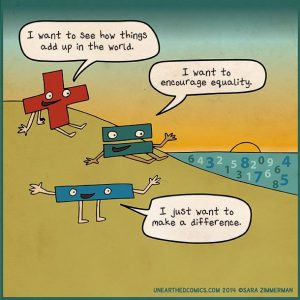2016 NC Council of Teachers of Mathematics Conference
December 22, 2016
By Padgett Sullivan and Cydney Kramer
In November, Cydney and I attended the North Carolina Council of Teachers of Mathematics Conference (NCCTM), in Greensboro NC. We were joined by hundreds of other North Carolina math teachers, coaches, and facilitators. It was exciting to be in a place with so many other education professionals who value math education as much as the Heart team! We had many of our mathematical beliefs confirmed, but also learned important new things about how to best support our students! We’ve summarized some of our findings below.
The Role of Assessment in Math
“Test less, assess more.” While that may seem contradictory, tests are generally summative and let us know what a student has mastered. An assessment lets us know where students are in the process toward mastery and allows us adjust our instruction accordingly. Blurring the line between instruction and assessment allows us to better tailor our instruction. The implication for Heart is that mini-assessments need to not only be a test at the end of a notebook, but an avenue for the coordinator and tutor to learn (at any point along the way toward mastery) what a student is able to do and what he/she still needs to work on. A “failed” mini-assessment is not a failure at all – it gives us important information about a student’s mathematical understanding. For example, you may learn that a student can tell you easily “how many less” when the two quantities are only one or two different but has trouble keeping track when the difference is larger.
An Operational view of the Equal Sign vs. a Relational view
“Whatever value you have on the left, you must have on the right.” After listening to the researcher Zachary Champagne talk about students’ understanding of the equal sign and watching videos of students explaining it, Cydney and I were stunned by how many students believe the equal sign means “answer.” When given true false equations, most students didn’t believe that 4=4 was true, or that 2+3=3+2 was true, as they had only ever seen equations with an addition or subtraction problem on the left, and the “answer” on the right. If students are never exposed to anything else, it is understandable that they would find those equations odd or even untrue. It is important for coordinators and tutors to help students understand that the equal sign indicates a balance and means “the same as” rather than “put answer here.” In addition to some minor curriculum updates which will allow students to see equations in a variety of ways, coordinators can and should “push in” to correct students’ operational view of the symbol to prepare them for algebra and other higher level math. See Heart’s two-minute tutoring tip here!
Mindsets in Math
As we all know, students’ mindset about math greatly affects their performance in math. It is for this reason that one of Heart’s core values is “growth mindset.” It is important for students to see mistakes as learning experiences and as a natural, healthy consequence of trying. It is important for coordinators and tutors to continue to instill in their students a growth mindset (rather than fixed mindset, where intelligence is predetermined at birth), so that they persevere through challenges in math and in life. Coordinators can ensure that tutors are asking students the metacognition and reflection questions as they are leaving the tutoring room. “What was hard about today? What was easy? What do I need more practice on?” This gets students into the habit of reflecting on their effort and normalizes the idea that some things are easy and some things are hard. It is only by struggling through the hard things that our brains grow and become stronger!
Categories
- Blog (252)
- Events (28)
- Grants and Funding News (33)
- Heart Families (9)
- Heart News (152)
- Heart Staff (16)
- Math Matters (38)
- Press (65)
- Student Spotlight (1)
- Uncategorized (43)
- Volunteer Partners (12)
- Volunteer Resources (41)
- Volunteer Spotlight (52)
Recent Posts
- 2025 Volunteer Appreciation Month Spotlight Series
- Tutor Spotlight: LaShurn Purnell
- 2024 NAEP Results
- Heart Featured on Charleston’s Live 5 News
- Racing to 100 Tutors Across the Carolinas!
- Accelerate and Johns Hopkins University Visit HMT Tutoring Session
- Tutor Spotlight: Libby Anderson
- Tutor Spotlights: Alyson and Michael Fotia
- Heart Featured on Winston-Salem’s WXII 12 News
- Volunteer with Heart!

